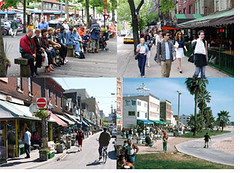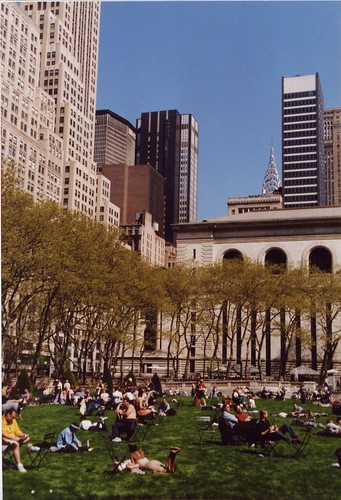Great article on the Project for Public Spaces and Fred Kent
 I keep forgetting to mention this great article, "Pride of Place: Fred Kent has spent three decades building a commonsense approach to streets, buildings, and human sociability" which appeared in the April issue of Governing magazine. One good thing about the wait is that in the interim, PPS posted a pdf file of the original article, which includes photos with legends explaining various points about placemaking (i.e., movable seating allows people to customize their use of a space, that blank walls discourage pedestrians, etc.)
I keep forgetting to mention this great article, "Pride of Place: Fred Kent has spent three decades building a commonsense approach to streets, buildings, and human sociability" which appeared in the April issue of Governing magazine. One good thing about the wait is that in the interim, PPS posted a pdf file of the original article, which includes photos with legends explaining various points about placemaking (i.e., movable seating allows people to customize their use of a space, that blank walls discourage pedestrians, etc.)Fred Kent prefers to use the term placemaking rather than the phrase I often use: "urban design"; in part to emphasize the intimate link between people and places. I particularly like this paragraph of the story:
"They [PPS] have plenty of suggestions for creating the sort of clutter on a street that people like, for the way buildings ought to behave--don't create blank walls, don't confront pedestrians with the heating and air conditioning infrastructure, don't lard a block with curb cuts--and for layering attractions that gather people in. 'If you have a children's reading room inside and a playground outside,' says Kent, 'then you put a coffee shop, a Laundromat and a bus stop right there, you will create the busiest spot in your community."
I especially like the phrase "layering attractions that gather people in" that's really what it's all about, and it is something that I push on the various things I get involved in locally. The rhythm of the street, storefronts, etc., is key.
 I am a big fan of the PPS workshop (and book) "How to Turn a Place Around," which teaches people about placemaking and how to apply the principles to their own communities.
I am a big fan of the PPS workshop (and book) "How to Turn a Place Around," which teaches people about placemaking and how to apply the principles to their own communities.The article, "Great Commons of the World," from Yes Magazine, also features Fred Kent and PPS, and this text sums up the PPS philosophy in a heartbeat:
"The best commons are hubs of city life where there’s always something going on. Activities are the “basic building blocks” of a commons, Kent says. They’re what draws people and what brings them back. Outdoor cafes provide a chance for people-watching, a favorite common-space activity. Public markets and other food-centered activities are good attractions, too, and people love to sit near fountains and touch the water. Seating, Kent has found, is critical. Movable chairs are particularly appealing, but permanent benches in the right spots can dramatically improve a visitor’s experience.
The great commons are also highly visible and easy to get to — not just by car, but on foot, by bicycle, and by public transit. This quality gives a community a convenient connection to its public places and makes it easy for people to circulate within them. The most successful commons are on the way to popular destinations and are destinations themselves.
Safety and cleanliness are important, so an apparent management presence and simple, practical amenities such as plentiful waste receptacles and restrooms make a big difference. One measure of a successful commons, Kent notes, is that it attracts women and children, who are more discriminating about safety and seating.
More important are character and charm. Is the space inviting and visually pleasing? Are there sculptures? Shade trees? Fountains? Do people seem to be happy there, showing affection toward each other, touching, kissing?
Ultimately, as urban visionary William H. Whyte once noted, what attracts people is other people, especially unusual, colorful people — people with great faces, odd pets, strange clothes. If they’re involved in interesting activities, so much the better. Outstanding community commons provide focal points for public gatherings and accommodate a variety of social activities, from concerts to art fairs to just plain conversations."
 One of PPS's great successes is Bryant Park in Manhattan, where among many ideas, they brought movable chairs and tables to the park.
One of PPS's great successes is Bryant Park in Manhattan, where among many ideas, they brought movable chairs and tables to the park.



0 Comments:
Post a Comment
<< Home